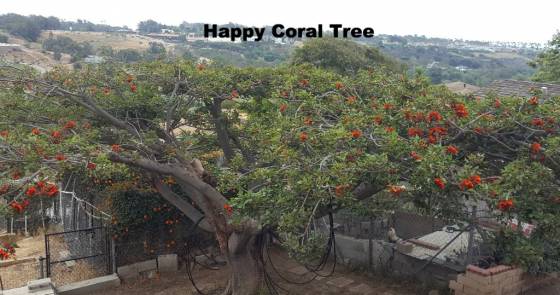This disease causes the leaves of plants and trees to wither, and eventually, the plant dies. It can be a slow death taking a few years or months or even sooner. This is basically a soil mismanagement problem and should be addressed as such.
This is a disease that is hard to kill chemically. Fungicides do not work because it doesn’t address the root cause of the problem. Your soil is dying! By not paying attention to the basics of having healthy topsoil, and by over-watering, by applying chemical fertilizers, you have damaged the essential functions of the soil which is to deliver much needed essential minerals and nutrients to the plants and trees. Another essential function is to fight off any of the “bad guys” in the soil. Many folks in Malibu are losing their Coral Trees, that getting infected with this disease because of bad pruning healthy trees with infected tools which were used on an infected tree, combined with improper watering and improper soil care as well as by using chemical fertilizers. One should always clean tools with bleach or rubbing alcohol, or Verticillium Wilt will spread. It is also easily carried by insects and birds and through the wind, if an infected Coral Tree was pruned nearby or across the street. Verticillium disease overwinters in decaying plant matter and can survive from 10 up to 15 years. So by merely cutting down an infected tree, you have just provided the whole area with a source of this disease that is waiting for the right conditions to grow and expand.
The air – soil temperature needs to be warm 60 to 80 degrees Fahrenheit. Alkaline soil (which we have here in Malibu) and high nitrogen fertilizers only promotes its growth and makes it worse. Adding live microbial compost will provide the microbial army to combat this disease. Remember, the good guys and the bad guys do not live in the same place. This disease, like most soil-borne diseases, often show up when hot, dry weather begins and that is also when your gardener waters and fertilizes more, further increasing the problem.
Many other factors can cause leaf wilt and branch dieback. In general, adverse site conditions such as construction work, digging a trench, damaging the trunk and environmental stress such as high heat, root injury, drought, flooding, compaction, can also cause symptoms that are similar to verticillium and can be mistaken for that disease. There are also many other types of canker-causing fungi that damage the bark and cambium to cause wilting in the trees leaves. Bark beetles, boring insects, etc., can attack and cause enough damage to a tree that would result in the same damage. One needs to be certain and therefore get a lab, soil test to determine if the cause is verticillium or something else.
While there is no chemical fungicide treatment available to control Verticillium wilt, there are many things you can do Organically. Besides correct cultural care such as proper pruning and cleaning tools in-between cuttings, proper deep watering and organic fertilizing, you must start the short term and long term solutions.
Deep-watering through a drip or subsurface irrigation and not more than once a week during hot times, depending on the health of the soil is a good start. Watering once a month is an ideal goal. Do not fertilize with any chemical fertilizer as they almost always are high nitrogen-based. Before you apply any type of organic fertilizers, you will need to apply rock dust, live compost and azalea/gardenia mix which is an acid earthworm casting mulch. This will help to reduce the ph. The rock dust is a source of minerals which the compost will use and make available to the plants and trees. This is both short term and long term in the sense that as short-term it starts to protect the soil from further damage and as long-term it will start to bring the root systems back to functioning levels.
The application of organic fertilizer with microbes will help the tree to recover but slowly and must be applied several times per year.
You should start foliar spraying the tree(s) in question to allow them to absorb the essential minerals and nutrients. You can also do soil injections with highly mineralized compost tea. Compost tea is also an excellent foliar/trunk/root spray.By increasing microbial activity both in the soil and on the tree’s leaves, it will reduce the activity of the disease as well as reduce the damaging effects.
Remember, all diseases are soil borne waiting for the right conditions to emerge. Over-watering destroys the soils ability to function, simple as that. Chemical fertilizers destroy the soils ability to function. A non-functioning soil does not have the proper Mycelium and always leads to trace mineral deficiency. The fungus, any fungus, need the host to be deficient in certain trace minerals before it can attack. It is much easier to keep your soil healthy then it is to get it to recover. Concentrate on keeping the water below ground, and you will have less moisture above ground which most fungus will need to survive and spread. Verticillium can be spread by wood-chips so be careful where you get your wood-chips.
Remember, do long-term solutions like amending the soil with live compost and applying an acid mulch, applying organic fertilizer, changing the water to below ground and only watering as needed once or twice a month. Short-term solutions are using an organic foliar spray alive with microbes and minerals. Doing soil treatments to encourage microbial growth also takes time. It will take time for the root systems to recover which it will do so as the soil recovers.
And Please stop over pruning the Coral Trees!
Any questions? Email me at andylopez@invisiblegardener.com
andy Lopez (yes, I use little a)
Invisible Gardener








